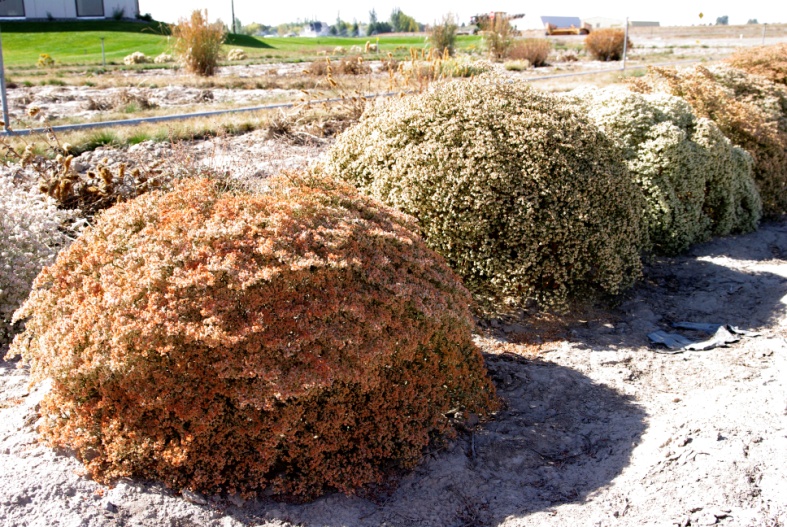Lacy Buckwheat in the Landscape

Stephen Love, University of Idaho
Scientfic Name: Eriogonum corymbosumCommon Name: Lacy buckwheat
Description: : Lacy buckwheat is a very long-lived, deciduous shrub. The best feature of this species is its ability to add interest and beauty to a xeric garden in late summer, fall, and through winter. During winter, the stems lose their leaves and die back to the base of the spent cymes. In spring, new leaves emerge and plants begin the process of renewing the unique dome-shaped canopy that is the special characteristic of the species. As branches of the numerous inflorescences develop and intertwine, the form becomes very dense and stiff. Masses of white to pink (sometimes yellow) flowers cover the plants in late summer and early fall. After bloom, the flowers change color to dark tones of red and copper. The inflorescence structure remains intact through the winter, lending color and form to the starkness of the winter garden. Lacy buckwheat is one of the unique and great native plants of the Intermountain West.
Native Habitat: Eriogonum corymbosum, is primarily a species of the red rock country of Utah and northern Arizona but extends into adjoining regions of Wyoming, Colorado, New Mexico, and Nevada. It typically grows at moderate elevations, 4,000 to 8,000 feet, on rocky flats, slopes, and ledges. Common plant communities include pinyon/juniper, shrub steppe, and salt desert scrub. Lacy buckwheat is a common roadside plant within its habitat.
Cultural Requirement
Soil: Well-drained soil is essential for long-term survival of this species. Tolerates clay soils if grown in a dry climate or not over-watered. Adapted to alkaline soils. Shows best form in nutrient-poor soils.
Moisture Tolerance: Capable of growing under completely xeric conditions and will not survive heavily irrigated circumstances. Grows well in gardens where limited amounts of supplemental water are applied during the hottest months of the summer.
Sun/Shade/Preference: Full sun.
Transplanting: Easily transplanted as seedlings from flats into pots and from pots into the garden. Potted plants may not reach marketable size the first summer unless started very early. Plants are easily managed in small pots for a short period of time but require well-drained media and careful watering to remain healthy for an extended period of time. Makes a good subject for one-gallon pots if cared for properly.
Propagation: Best propagated from seed. Germinates at high rates without any seed pre-treatments. Seedlings can be extremely susceptible to damping-off. Ensure proper watering of young seedlings, avoid crowding the young seedlings, and possibly use an appropriate preventative fungicide mixed into the propagation medium. Seedlings that make it to the 3- or 4-leaf stage are much more resistant to damping-off. Lacy buckwheat is difficult to propagate from cuttings.
Maintenance (pruning, fertilization, deadheading, division, irrigation, etc): Lacy buckwheat plants require very little maintenance. If sheared in the spring below the old inflorescences, new spring growth will emerge more quickly. Fertilizer is rarely needed, even in lean soils, and over-fertilization causes the plants to become rank and floppy. Limited irrigation (one to four times during dry years) can be applied but is not essential.
Insect, disease, or other problems: Lacy buckwheat has no pests of consequence.
Landscape Value
Use in the Landscape: Lacy buckwheat is a remarkable plant for a xeric landscape. The unique architecture makes it ideal as a specimen plant or as a repeated element to complement other plants. It can be used very effectively in a formal design, but also works well in a naturalized garden. Smaller forms of the species make excellent rock garden plants. Other than a brief period of lankiness in early spring, this species is consistently attractive and interesting.
Weediness/Invasive Potential:
Foliage: The plants develop no basal leaf mat. The small, crinkled leaves grow sparsely up and down the stems. The leaves range in color from dark green to light gray-green. The leaves are not important to the aesthetic value of the plant, are rapidly overgrown by the flowering stems, and are usually not visible.
Flower: On mature plants, thousands of tiny white or pink flowers grow on highly branched terminal cymes. Flowers of one botanical variety are bright yellow. The bloom period is moderately long (10 weeks) and occurs late in the season, August through October.
Timing: August-October.
Fruit: Inconspicuous achene enclosed in a dried perianth. Each flower produces a maximum of one seed.
Form: Dense half-spherical.
Texture: Fine.
Ultimate Size: Lacy buckwheat is extremely variable for size, and selection of plants from a specific geographical region dictates ultimate size. Following inflorescence development in summer, small forms may be less than 1 foot tall with similar spread. Large forms can be over 4 feet tall and 5 feet wide.
Rate of Growth: Moderate. Lacy buckwheat grows faster than most other Eriogonum species, but still would not be considered fast-growing. Plants usually bloom the first year but sparse habit of the young plants limits the appeal of the initial flowers. By the third year, plants begin to express their full potential and fascinating mature form.
Suggested Plant Partners: Companions for lacy buckwheat should be xeric in nature. Also, selection of companions should be determined by desired effect. If lacy buckwheat is to be the dominant specimen plant in the landscape, use small plants arranged around the globe-shaped buckwheat plants, such as: Penstemon linarioides, Oenothera caespitosa, Calylophus lavandulifolius, Sphaeralcea munroana, Sedum lanceolatum, Hymenoxys acaulis, Festuca idahoensis, and Achnatherum hymenoides. Cactus species, such as Echinocereus, triglochidiatus, or Pediocactus simpsonii can be very effective. If used as a complementary element, place lacy buckwheat around taller xeric plants, such as: Ericameria nauseosa, Penstemon palmeri, Leymus cinereus, Chamaebatiaria millefolium, and Cercocarpus ledifolius.
Availability: Seed can usually be purchased from the Eriogonum Society or from native plant seed suppliers. Potted plants are rarely available.
Cultivars: None.
References:

